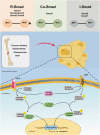The Smad Dependent TGF-β and BMP Signaling Pathway in Bone Remodeling and Therapies
- PMID: 34026818
- PMCID: PMC8131681
- DOI: 10.3389/fmolb.2021.593310
The Smad Dependent TGF-β and BMP Signaling Pathway in Bone Remodeling and Therapies
Abstract
Bone remodeling is a continuous process that maintains the homeostasis of the skeletal system, and it depends on the homeostasis between bone-forming osteoblasts and bone-absorbing osteoclasts. A large number of studies have confirmed that the Smad signaling pathway is essential for the regulation of osteoblastic and osteoclastic differentiation during skeletal development, bone formation and bone homeostasis, suggesting a close relationship between Smad signaling and bone remodeling. It is known that Smads proteins are pivotal intracellular effectors for the members of the transforming growth factor-β (TGF-β) and bone morphogenetic proteins (BMP), acting as transcription factors. Smad mediates the signal transduction in TGF-β and BMP signaling pathway that affects both osteoblast and osteoclast functions, and therefore plays a critical role in the regulation of bone remodeling. Increasing studies have demonstrated that a number of Smad signaling regulators have potential functions in bone remodeling. Therefore, targeting Smad dependent TGF-β and BMP signaling pathway might be a novel and promising therapeutic strategy against osteoporosis. This article aims to review recent advances in this field, summarizing the influence of Smad on osteoblast and osteoclast function, together with Smad signaling regulators in bone remodeling. This will facilitate the understanding of Smad signaling pathway in bone biology and shed new light on the modulation and potential treatment for osteoporosis.
Keywords: Smad signaling pathway; bone morphogenetic proteins; bone remodeling; osteoporosis; transforming growth factor-β.
Copyright © 2021 Zou, Chen, Teng, Liu, Jia, Zhang, Sun, Wu, Yuan, Feng, Li, Xu and Yuan.
Conflict of interest statement
The authors declare that the research was conducted in the absence of any commercial or financial relationships that could be construed as a potential conflict of interest.
Figures


Similar articles
-
TGF-β and BMP signaling in osteoblast differentiation and bone formation.Int J Biol Sci. 2012;8(2):272-88. doi: 10.7150/ijbs.2929. Epub 2012 Jan 21. Int J Biol Sci. 2012. PMID: 22298955 Free PMC article. Review.
-
TGF-β and BMP signaling in osteoblast, skeletal development, and bone formation, homeostasis and disease.Bone Res. 2016 Apr 26;4:16009. doi: 10.1038/boneres.2016.9. eCollection 2016. Bone Res. 2016. PMID: 27563484 Free PMC article. Review.
-
Concerted action of Smad and CREB-binding protein regulates bone morphogenetic protein-2-stimulated osteoblastic colony-stimulating factor-1 expression.J Biol Chem. 2006 Jul 21;281(29):20160-70. doi: 10.1074/jbc.M511071200. Epub 2006 May 17. J Biol Chem. 2006. PMID: 16707491
-
Biphasic effects of transforming growth factor β on bone morphogenetic protein-induced osteoblast differentiation.J Bone Miner Res. 2011 Jun;26(6):1178-87. doi: 10.1002/jbmr.313. J Bone Miner Res. 2011. PMID: 21611961
-
Bone morphogenetic proteins.Growth Factors. 2004 Dec;22(4):233-41. doi: 10.1080/08977190412331279890. Growth Factors. 2004. PMID: 15621726 Review.
Cited by
-
New Insights into Antioxidant Peptides: An Overview of Efficient Screening, Evaluation Models, Molecular Mechanisms, and Applications.Antioxidants (Basel). 2024 Feb 5;13(2):203. doi: 10.3390/antiox13020203. Antioxidants (Basel). 2024. PMID: 38397801 Free PMC article. Review.
-
Unraveling the potential mechanisms of the anti-osteoporotic effects of the Achyranthes bidentata-Dipsacus asper herb pair: a network pharmacology and experimental study.Front Pharmacol. 2023 Oct 2;14:1242194. doi: 10.3389/fphar.2023.1242194. eCollection 2023. Front Pharmacol. 2023. PMID: 37849727 Free PMC article.
-
Transcriptome changes during osteogenesis of porcine mesenchymal stem cells derived from different types of synovial membranes and genetic background.Sci Rep. 2023 Jun 21;13(1):10048. doi: 10.1038/s41598-023-37260-4. Sci Rep. 2023. PMID: 37344635 Free PMC article.
-
The Role of Twisted Gastrulation 1 (TWSG1) Gene in TGF-β Signaling Linked to Cancer: A Comprehensive Review.Asian Pac J Cancer Prev. 2025 Apr 1;26(4):1129-1138. doi: 10.31557/APJCP.2025.26.4.1129. Asian Pac J Cancer Prev. 2025. PMID: 40302064 Free PMC article. Review.
-
Osteogenic Differentiation of Mesenchymal Stem Cells Induced by Geometric Mechanotransductive 3D-Printed Poly-(L)-Lactic Acid Matrices.Int J Mol Sci. 2025 Aug 2;26(15):7494. doi: 10.3390/ijms26157494. Int J Mol Sci. 2025. PMID: 40806620 Free PMC article.
References
-
- Broege A., Pham L., Jensen E. D., Emery A., Huang T.-H., Stemig M., et al. (2013). Bone Morphogenetic Proteins Signal via SMAD and Mitogen-Activated Protein (MAP) Kinase Pathways at Distinct Times during Osteoclastogenesis. J. Biol. Chem. 288, 37230–37240. 10.1074/jbc.M113.496950 - DOI - PMC - PubMed
Publication types
LinkOut - more resources
Full Text Sources
Other Literature Sources

